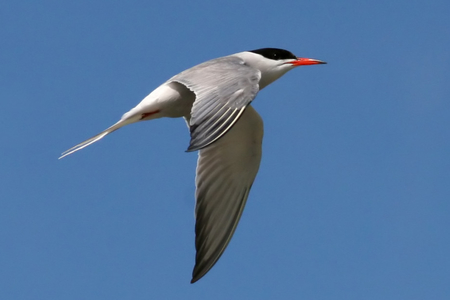Sterna hirundo hirundo
Family: Laridae
Length: 31 – 39 cm
Wingspan: 72 – 98 cm
Weight: 90 – 165 g

Identification
Appearance: medium-sized seabird with light grey upperparts, white to very light grey underparts, black cap, orange-red legs, narrow pointed red bill with a black tip at the end.
Distinguishing characteristics: black tip at the end of the red bill.
Flight: smooth, fast and elegant.
Sound: wide repertoire of calls such as high and grating « kee-yah », « kye-kye-kye-kye… » or characteristic « kirri-kirri ».
Ecology and habitat
Nest: breeds on exposed rocky cliffs, offshore islands or islets.
Diet: feeds primarily on fish, also molluscs, crustaceans and other invertebrates.
Behaviour at sea: coastal species, rarely occurring inland and generally not travelling far offshore.
* This map indicates coastal nesting sites in the Mediterranean and adjacent Seas.
Distribution and movement
Breeding: the species is cosmopolite; the subspecies Sterna hirundo hirundo breeds within the European continent inland (rivers and lakes) or on the coast (rocky islets, beaches and on the edge of marshes).
Wintering: off the coast of Africa.
Phenology: incubation: 21-25 days; two or three eggs. Fledging: 22-28 days.
Conservation
Global population estimate: European population: 316,000 – 605,000 pairs.
Threats: habitat loss, colony disturbance, predation and pesticides.
Protection level: Barcelona Convention : Annex II; Bern Convention : Annex II; Birds Directive : Annex I; IUCN Red List: Least Concern.
Some key references
BirdLife International (2021) Species factsheet: Sterna hirundo.
Kralj J., Martinović M., Jurinović L., Szinai P., Sütő S., Preiszner B. 2020. Geolocator study reveals east African migration route of Central European Common Terns. Avian Research 11(1): 1-11.
Scarton F. 2010. Long term decline of a Common Tern (Sterna hirundo) population nesting in salt marshes in Venice lagoon, Italy. Wetlands 30(6): 1153-1159.
